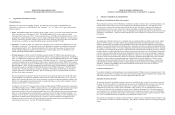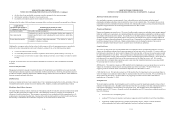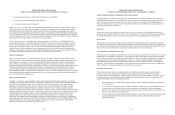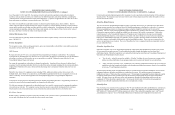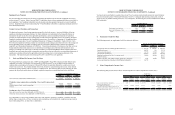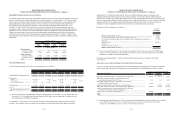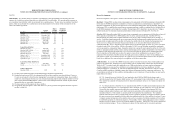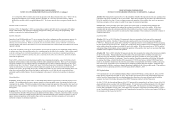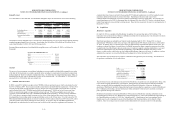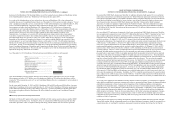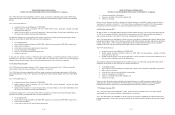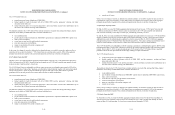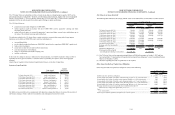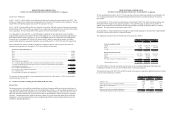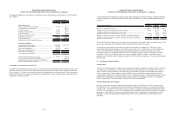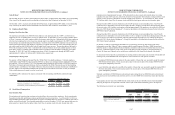Dish Network 2012 Annual Report Download - page 69
Download and view the complete annual report
Please find page 69 of the 2012 Dish Network annual report below. You can navigate through the pages in the report by either clicking on the pages listed below, or by using the keyword search tool below to find specific information within the annual report.
DISH NETWORK CORPORATION
NOTES TO CONSOLIDATED FINANCIAL STATEMENTS - Continued
T2. In December 2007, TerreStar entered into an agreement with Space Systems/Loral, Inc. (“SS/L”) for the
design and manufacture of T2, formerly known as EchoStar T2. Since the construction of T2 is almost
finished, the satellite could be completed during 2013. We do not currently have an expected launch date for
T2.
Satellites Under Construction
EchoStar XVIII. On September 7, 2012, we entered into a contract with SS/L for the construction of EchoStar
XVIII, a DBS satellite with spot beam technology designed for, among other things, HD programming. This
satellite is expected to be launched during 2015.
Satellite Anomalies
Operation of our DISH branded pay-TV service requires that we have adequate satellite transmission capacity for
the programming we offer. Moreover, current competitive conditions require that we continue to expand our
offering of new programming. While we generally have had in-orbit satellite capacity sufficient to transmit our
existing channels and some backup capacity to recover the transmission of certain critical programming, our backup
capacity is limited.
In the event of a failure or loss of any of our satellites, we may need to acquire or lease additional satellite capacity
or relocate one of our other satellites and use it as a replacement for the failed or lost satellite. Such a failure could
result in a prolonged loss of critical programming or a significant delay in our plans to expand programming as
necessary to remain competitive and thus may have a material adverse effect on our business, financial condition
and results of operations.
Prior to 2012, certain of our owned and leased satellites have experienced anomalies, some of which have had a
significant adverse impact on their remaining useful life and/or commercial operation. There can be no assurance
that future anomalies will not further impact the remaining useful life and/or commercial operation of any of the
satellites in our fleet. See Note 2 “Long-Lived Assets” for further discussion of evaluation of impairment. There
can be no assurance that we can recover critical transmission capacity in the event one or more of our in-orbit
satellites were to fail. We generally do not carry commercial insurance for any of the in-orbit satellites that we use,
other than certain satellites leased from third parties, and therefore, we will bear the risk associated with any
uninsured in-orbit satellite failures. Recent developments with respect to certain of our satellites are discussed
below.
Owned Satellites
EchoStar I. During the first quarter 2012, we determined that EchoStar I experienced a communications receiver
anomaly. The communications receivers process signals sent from our uplink center for transmission back to our
customers by the satellite. While this anomaly did not impact commercial operation of the satellite, there can be no
assurance that future anomalies will not impact its future commercial operation. EchoStar I was fully depreciated
during 2007.
EchoStar VII. Prior to 2012, EchoStar VII experienced certain thruster failures. During the fourth quarter 2012,
we determined that EchoStar VII experienced an additional thruster failure. Thrusters control the satellite’s location
and orientation. While this anomaly did not reduce the estimated useful life of the satellite to less than 15 years or
impact commercial operation of the satellite, there can be no assurance that future anomalies will not reduce its
useful life or impact its commercial operation.
F-28
DISH NETWORK CORPORATION
NOTES TO CONSOLIDATED FINANCIAL STATEMENTS - Continued
EchoStar XI. During the first quarter 2012, we determined that EchoStar XI experienced solar array anomalies that
reduced the total power available for use by the satellite. While these anomalies did not reduce the estimated useful
life of the satellite to less than 15 years or impact commercial operation of the satellite, there can be no assurance
that future anomalies will not reduce its useful life or impact its commercial operation.
EchoStar XIV. During the third quarter 2011 and the first quarter 2012, we determined that EchoStar XIV
experienced solar array anomalies that reduced the total power available for use by the satellite. While these
anomalies did not reduce the estimated useful life of the satellite to less than 15 years or impact commercial
operation of the satellite, there can be no assurance that future anomalies will not reduce its useful life or impact its
commercial operation.
Leased Satellites
EchoStar VI. Prior to 2012, EchoStar VI experienced solar array anomalies which impacted the commercial
operation of the satellite. EchoStar VI also previously experienced the loss of traveling wave tube amplifiers
(“TWTAs”). During the first quarter 2012, EchoStar VI experienced the loss of two additional TWTAs increasing
the total number of TWTAs lost to five. During the second quarter 2012, EchoStar VI lost an additional solar array
string, which reduced the total power available for use by the satellite. While the recent losses of TWTAs and the
solar array strings did not impact current commercial operation of the satellite, there can be no assurance that future
anomalies will not impact its commercial operation.
EchoStar XII. Prior to 2012, EchoStar XII experienced solar array anomalies that reduced the total power available
for use by the satellite. During September and November 2012 and January 2013, EchoStar XII experienced
additional solar array anomalies, which further reduced the total power available for use by the satellite. An
investigation of the anomalies is continuing. Since the number of useable transponders on EchoStar XII depends
on, among other things, whether EchoStar XII is operated in CONUS, spot beam, or hybrid CONUS/spot beam
mode, we are unable to determine at this time the actual number of transponders that will be available at any given
time or how many transponders can be used during the remaining estimated life of the satellite. Additional solar
array anomalies are likely to continue to degrade operational capability in all of the possible modes. This satellite is
currently in-service and projected to be an in-orbit spare effective March 1, 2013.
FCC Authorizations
“FCC authorizations” on our Consolidated Balance Sheets totaled $3.297 billion as of December 31, 2012, a $1.905
billion increase compared to December 31, 2011. This increase was related to the closing of the DBSD Transaction
and the TerreStar Transaction and the associated purchase price allocation to the assets acquired and the liabilities
assumed. See Note 10 for further discussion of the DBSD Transaction and the TerreStar Transaction.
On May 31, 2012, the International Bureau of the FCC announced the termination of our license for use of the 148
degree orbital location associated with our DISH segment. We had not had a satellite positioned at the 148 degree
orbital location since the retirement of EchoStar V in August 2009. Our license for use of the 148 degree orbital
location had a $68 million carrying value. This amount was recorded as “Depreciation and amortization” expense
on our Consolidated Statements of Operations and Comprehensive Income (Loss) in the second quarter 2012 due to
the termination of this license by the FCC.
F-29


